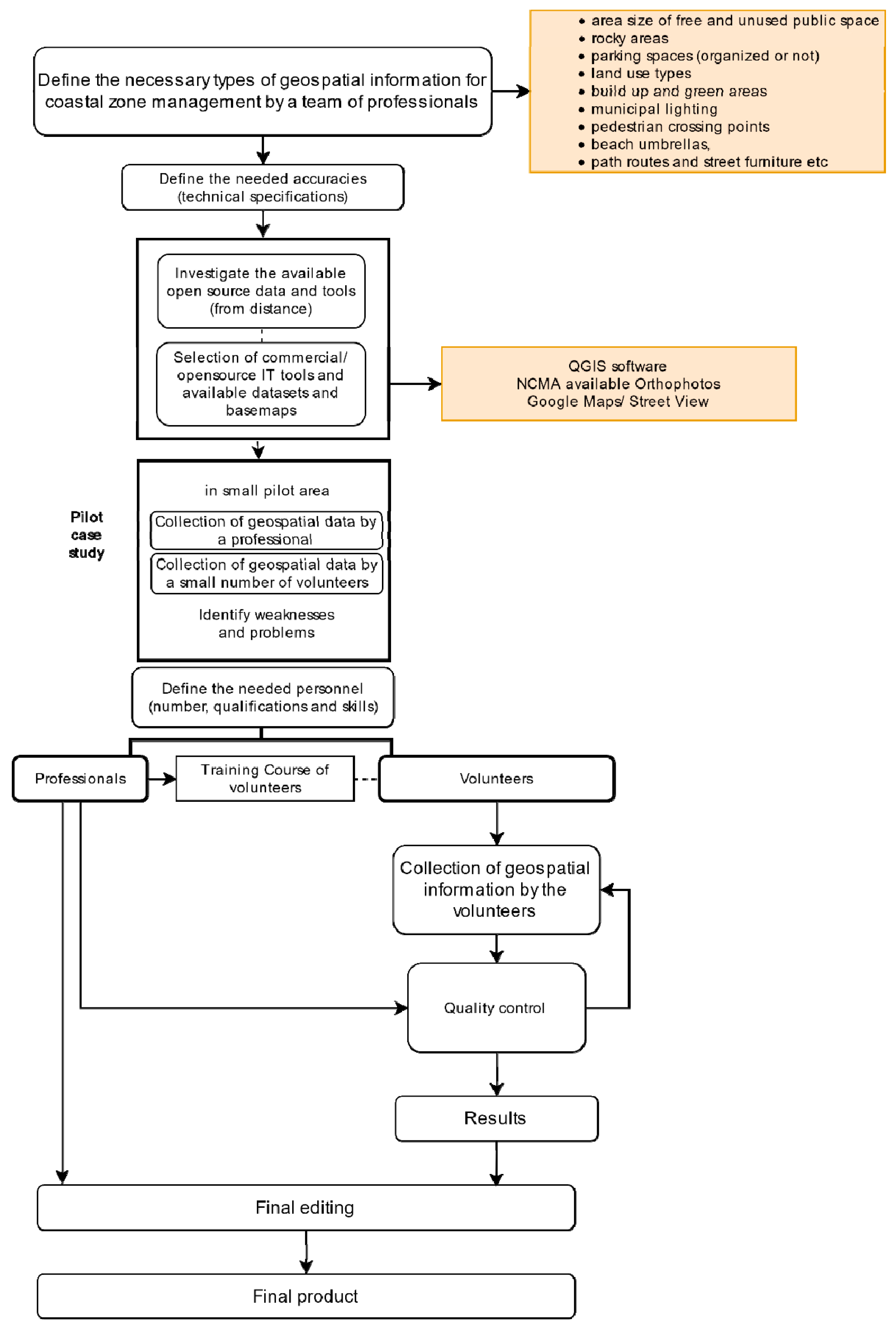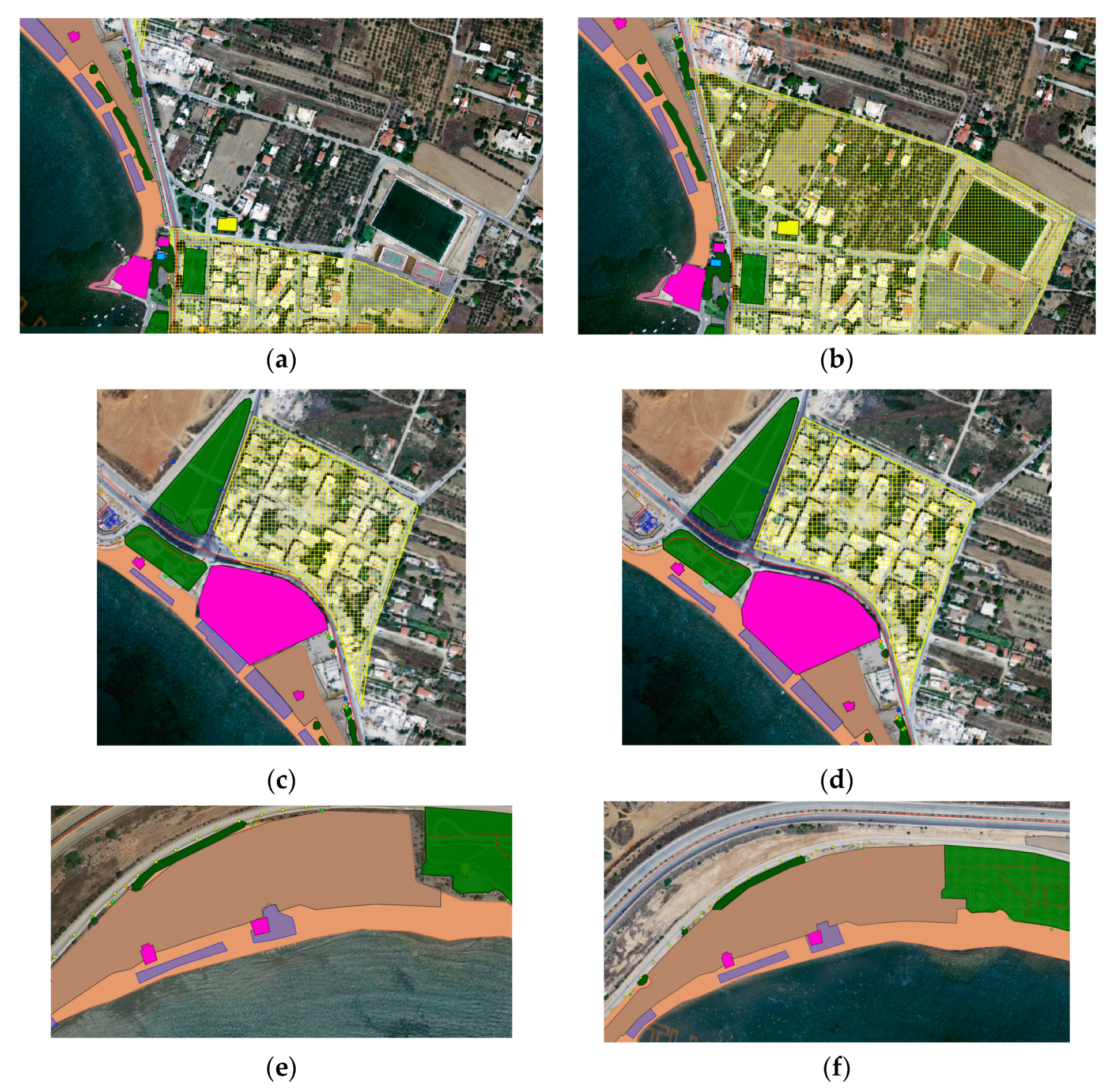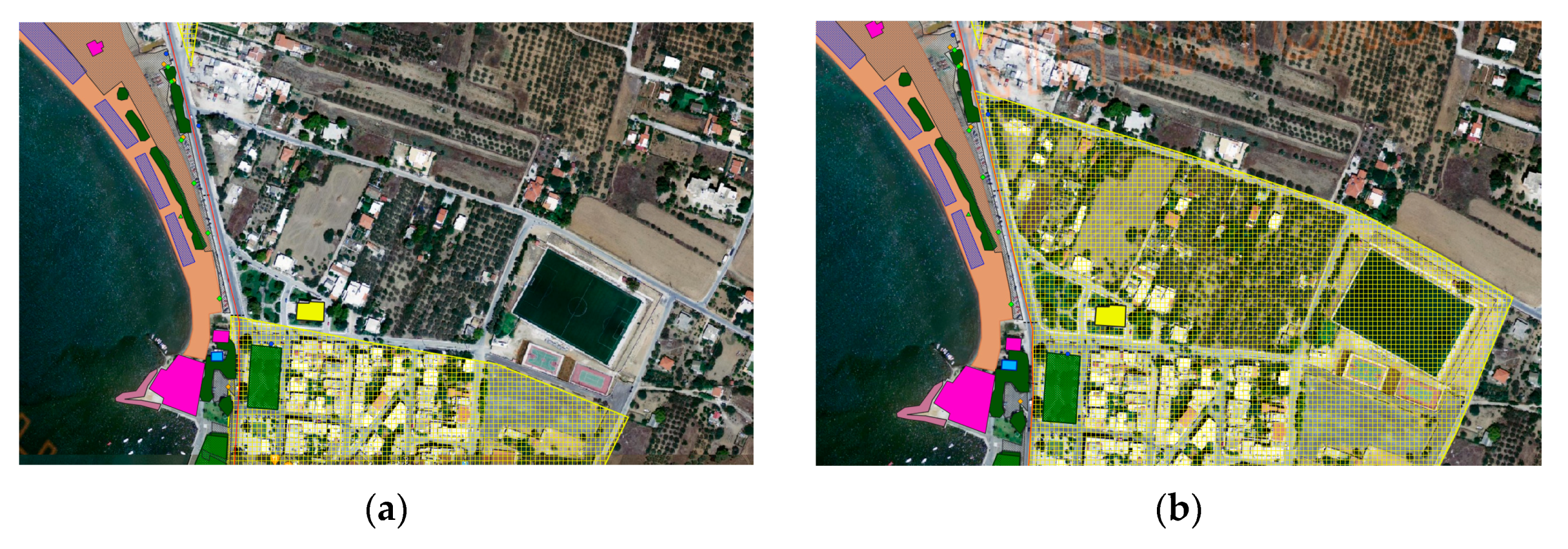Crowdsourced Geospatial Infrastructure for Coastal Management and Planning for Emerging Post COVID-19 Tourism Demand
Abstract
1. Introduction
2. Literature Review
2.1. Tourism Trends in the Region of Attica
2.2. VGI and Crowdsourcing for Geospatial Information Collection
3. Methodology
3.1. Defining the Study Area
3.2. Data Collection by the Small Team of Volunteers
3.3. Quality Control and Editing by a Professional
4. Assessment of Strengths and Weaknesses and the Limitations of the Proposed Methodology
5. Conclusions
Author Contributions
Funding
Institutional Review Board Statement
Informed Consent Statement
Data Availability Statement
Acknowledgments
Conflicts of Interest
References
- Lainas, I. Land-sea interactions and maritime spatial planning guidelines in the context of European Union. The case of Greece. Int. J. Real Estate Land Plan. 2018, 1, 365–376. [Google Scholar] [CrossRef]
- Papageorgiou, M. Coastal and marine tourism: A challenging factor in Marine Spatial Planning. Ocean Coast. Manag. 2016, 129, 44–48. [Google Scholar] [CrossRef]
- Iliadis, F.; Kyriakidis, C.; Sioutopoulou, A. Management of the coastal zone: An important issue of modern spatial planning. Studying the case of the region of East Macedonia and Thrace. In Proceedings of the 4th Environmental Conference of Macedonia, Thessaloniki, Greece, 14–17 March 2011. [Google Scholar]
- Tang, Z. Evaluating local coastal zone land use planning capacities in California. Ocean Coast. Manag. 2008, 51, 544–555. [Google Scholar] [CrossRef]
- Rempis, N.; Tsilimigkas, G.; Pavlogeorgatos, G. Coastal zones and marine spatial planning. The case of the Municipality of Ierapetra, Crete. In Proceedings of the 5th Pan-Hellenic Conference of Planning and Regional Development, Volos, Greece, 27–30 September 2018. [Google Scholar]
- Beriatos, E.; Papageorgiou, M. Spatial planning of maritime and coastal space: The case study of Greece in the Mediterranean Sea. In Spatial Planning-Urban Planning-Environment in the 21st Century: Greece-the Mediterranean Sea; Beriatos, E., Papageorgiou, M., Eds.; University of Thessaly Publications: Volos, Greece, 2010; pp. 189–204. [Google Scholar]
- Aggelidis, M.; Oikonomou, A. Land uses and effects on the coastal area of Greece. In Proceedings of the HELECO Conference, Athens, Greece, 3–6 February 2005. [Google Scholar]
- Potsiou, C.; Dimitriadi, K. Tools for legal integration and regeneration of informal development in Greece: A research study in the Municipality of Keratea. Surv. Land Inf. Sci. 2008, 68, 103–118. [Google Scholar]
- Potsiou, C. Informal urban development in Europe. In Experiences from Albania and Greece–Summary Version; FIG/UN HABITAT Publication: Greece, Athens, 2010; p. 121. ISBN 978-92-1-132266-8. [Google Scholar]
- Minetos, D.; Polyzos, S.; Sdrolias, L. Social and public responsibility and illegal urban land uses in Greece: An empirical investigation. In Proceedings of the Management of International Business and Economic Systems Conference (MIBES), Larsa, Greece, 4–5 November 2006. [Google Scholar]
- Loukogeorgaki, A.; Nikou, M.; Pantazopoulou, D.; Patelida, M. Planning of the coastal space in the era of climate change. In Proceedings of the ERSA-GR Conference, Patras, Greece, 25–26 June 2013. [Google Scholar]
- Potsiou, C. Formalizing the Informal: Challenges and Opportunities of Informal Settlements in South-East Europe; UNECE/FIG Publication: New Jork, NJ, USA; Geneva, Switzerland, 2015; p. 121. ISBN 978-87-92853-32-5. [Google Scholar]
- Bakogiannis, E.; Kyriakidis, C.; Siti, M.; Eleftheriou, V.; Siolas, A. Urban planning VS environment. Re conciliating the conflicts. In Proceedings of the 4th Pan-Hellenic Conference in Rural and Surveying Engineering, Thessaloniki, Greece, 26–28 September 2014. [Google Scholar]
- Barry, M.; Elema, I.; van der Molen, P. Ocean Governance in the Netherlands North Sea. New Professional Tasks. Marine Cadastres and Coastal Management. In Proceedings of the FIG Working Week, Paris, France, 13–17 April 2003. [Google Scholar]
- Beiqi, S.; Jinlin, Z.; Po-Ju, C. Exploring urban tourism crowding in Shanghai via crowdsourcing geospatial data. Curr. Issues Tour. 2017, 20, 1186–1209. [Google Scholar] [CrossRef]
- Lopes, J.M.; Oliveira, M.; Lopes, J.; Zaman, U. Networks, innovation and knowledge transfer in tourism industry: An empirical study of SMEs in Portugal. Soc. Sci. 2021, 10, 159. [Google Scholar] [CrossRef]
- Nunkoo, R.; Ramkissoon, H. Small island tourism: A residents’ perspective. Curr. Issues Tour. 2010, 13, 37–60. [Google Scholar] [CrossRef]
- Pavlogeorgatos, G.D.; Konstandoglou, M.E. Cultural tourism: The case of Greece. In Cultural Industries—Procedures, Services, Goods; Vernikos, N., Daskalopoulou, S., Badimaroudis, F., Boudaris, N., Papageorgiou, D., Eds.; Kritiki Publications: Athens, Greece, 2005; pp. 59–85. [Google Scholar]
- Andriotis, K. Alternative tourism and its various characteristics. TOPOS Rev. Spat. Dev. Environ. 2003, 20–21, 139–154. [Google Scholar]
- Theng, S.; Qiong, X.; Tatar, C. Mass tourism vs Alternative tourism? Challenges and new positioning. Études Caribéenne 2015, 31–32. Available online: https://journals.openedition.org/etudescaribeennes/7708 (accessed on 4 May 2021).
- Farmaki, A. An exploration of tourist motivation in rural settings: The case of Troodos, Cyprus. Tour. Manag. Perspect. 2012, 2, 72–78. [Google Scholar] [CrossRef]
- Valeri, M.; Fadlon, L. Sustainability in tourism: An originality and hospitality business in Italy. TOURISMOS 2016, 11, 1–18, ISSN 1790-8418. [Google Scholar]
- Butler, R.W. The concept of a tourist area cycle of evolution: Implication for management resources. Can. Geogr. 1980, 24, 5–12. [Google Scholar] [CrossRef]
- Turner, A. Introduction to Neogeography; O’Reilly Media, Inc.: Newton, MA, USA, 2006. [Google Scholar]
- Godchild, M. Citizens as sensors: The world of volunteered geography. GeoJournal 2007, 69, 211–221. [Google Scholar] [CrossRef]
- Surowiecki, J. The Wisdom of Crowds: Why the Many Are Smarter than the Few. 2004. Little Brown, NY; London; Toronto; Sydney; Auckland. Available online: https://sentry.rmu.edu/SentryHTML/pdf/lib_finn_DISC8710_wisdom_of_crowds.pdf (accessed on 11 March 2021).
- Hacklay, M.; Singleton, A.; Parker, C. Web mapping 2.0: The neogeography of the GeoWeb. Geogr. Compass 2008, 2, 2011–2039. [Google Scholar] [CrossRef]
- Stamatopoulou, C. 3D Digital Representation for Utilizing Tourist Routs in the Municipality of Lamia. Mastery Thesis, University of Thessaly, Volos, Greece, 2013. [Google Scholar]
- Flanagin, A.; Metzger, M. The credibility of volunteered geographic information. GeoJournal 2008, 72, 137–148. [Google Scholar] [CrossRef]
- Bakogiannis, E.; Siti, M.; Athanasopoulos, K.; Vassi, A.; Kyriakidis, C. Crowdsourcing and visual research methodologies to promote data collection for sustainable mobility planning. In Data Analytics: Paving the Way to Sustainable Urban Mobility. Proceedings of 4th Conference on Sustainable Urban Mobility (CSUM2018), Skiathos Island, Greece, 24–25 May 2018; Nathanail, E., Karakikes, D., Eds.; Springer: Cham, Switzerland, 2019; pp. 215–222. [Google Scholar]
- Füller, J.; Hutter, K.; Kröger, N. Crowdsourcing as a service—from pilot projects to sustainable innovation routines. Int. J. Proj. Manag. 2021, 39, 183–195. [Google Scholar] [CrossRef]
- Goodchild, M.F.; Li, L. Assuring the quality of Volunteered Geographic Information: The nature and motivation of procedures. Spat. Stat. 2012, 1, 110–120. [Google Scholar] [CrossRef]
- Coleman, D.; Geogriadou, Y.; Labonte, J. Volunteered Geographic Information: The nature and motivation of producers. Int. J. Spat. Data Infrastruct. Res. 2009, 4, 332–358. [Google Scholar]
- Sylaiou, S.; Basiouka, S.; Patias, P.; Stylianidis, E. Volunteered Geographic Information in archaeology. ISPRS Ann. Photogramm. Remote Sens. Spat. Inf. Sci. 2013, II-5/W1, 301–306. [Google Scholar] [CrossRef]
- Bakogiannis, E.; Kyriakidis, C.; Siti, M.; Iliadis, F.; Potsiou, C. Toward a methodology for noise mapping using VGI. In Proceedings of the FIG Commission 3 Annual Workshop and Annual Meeting, Volunteered Geographic Information, Lisbon, Portugal, 27–30 November 2017. [Google Scholar]
- Bakogiannis, E.; Kyriakidis, C.; Siti, M.; Kougioumtzidis, N.; Potsiou, C. The use of Volunteered Geographic Information (VGI) in noise mapping. In Proceedings of the GeoPreVi 2017, Bucharest, Romania, 14–15 September 2017. [Google Scholar]
- Mourafetis, G.; Apostolopoulos, K.; Potsiou, C.; Ioannidis, C. Enhancing cadastral surveys by facilitating the participation of owners. Surv. Rev. 2015, 47, 316–324. [Google Scholar] [CrossRef]
- Apostolopoulos, K.; Geli, M.; Petrelli, P.; Potsiou, C.; Ioannidis, C. A new model for cadastral surveying using crowdsourcing. Surv. Rev. 2018, 50, 122–133. [Google Scholar] [CrossRef]
- Cetl, V.; Ioannidis, C.; Dalyot, S.; Doytsher, Y.; Felus, Y.; Haklay, M.; Mueller, H.; Potsiou, C.; Rispoli, E.; Siriba, D. New Trends in Geospatial Information: The Land Surveyors Role in the Era of Crowdsourcing and VGI; International Federation of Surveyors (FIG): Copenhagen, Denmark, 2019; Article 73; ISSN 2311-8423. [Google Scholar]
- Potsiou, C.; Paunescu, C.; Ioannidis, C.; Apostolopoulos, K.; Nache, F. Reliable 2D Crowdsourced Cadastral Surveys: Case Studies from Greece and Romania. ISPRS Int. J. GeoInf. 2020, 9, 89. [Google Scholar] [CrossRef]
- Petrasova, A.; Hipp, J.A.; Mitasova, H. Visualization of pedestrian density dynamics using data extracted from public webcams. ISPRS Int. J. Geo-Inf. 2019, 8, 559. [Google Scholar] [CrossRef]
- Zhou, X.; Li, D. From stay to play—A travel planning tool based on crowdsourcing user-generated contents. Appl. Geogr. 2017, 78, 1–11. [Google Scholar] [CrossRef]
- Loren-Méndez, M.; Pinzón-Ayala, D.; Ruiz, R.; Alonso-Jiménez, R. Mapping HERITAGE: Geospatial online databases of historic roads. The case of the N-340 roadway corridor on the Spanish Mediterranean. ISPRS Int. J. GeoInf. 2018, 7, 134. [Google Scholar] [CrossRef]
- Pödör, A.; Révész, A.; Oscal, A.; Ladomerszki, Z. Testing some aspects of usability of crowdsourced smartphone generated noise maps. J. Geogr. Inf. Syst. 2015, 1, 354–358. [Google Scholar] [CrossRef]
- Apostolopoulos, K.; Potsiou, C. Consideration on how to introduce gamification tools to enhance citizen engagement in crowdsourced cadastral surveys. Surv. Rev. 2021, 1. [Google Scholar] [CrossRef]
- Basiouka, S.; Potsiou, C. 2012. VGI in cadastre: A Greek experiment to investigate the potential of crowdsourcing techniques in Cadastral Mapping. Surv. Rev. 2012, 44, 153–161. [Google Scholar] [CrossRef]
- Bennett, R.M.; Unger, E.-M.; Lemmen, C.; Dijkstra, P. Land administration maintenance: A review of the persistent problem and emerging fit-for-purpose solutions. Land 2021, 10, 509. [Google Scholar] [CrossRef]
- Ganti, R.; Ye, F.; Lei, H. Mobile crowdsensing: Current state and future challenges. IEEE Commun. Mag. 2011, 49, 32–39. [Google Scholar] [CrossRef]
- Xiao, Y.; Simoens, P.; Pillai, P.; Ha, K.; Satyanarayanan, M. Lowering the barriers to large-scale mobile crowdsensing. In Proceedings of the 14th Workshop on Mobile Computing Systems and Applications, Jekyll Island, GA, USA, 26–27 February 2013. [Google Scholar]
- Cardone, G.; Foschini, L.; Bellavista, P.; Corradi, A.; Borcea, C.; Talasila, M.; Curtmola, R. Fostering participation in smart cities: A geo-social crowdsensing platform. IEEE Commun. Mag. 2013, 51, 112–119. [Google Scholar] [CrossRef]
- Yang, D.; Xue, G.; Fang, X.; Tang, J. Incentive mechanisms for crowdsensing: Crowdsourcing with smartphones. IEEE/ACM Trans. on Netw. (TON). 2016, 24, 1732–1744. [Google Scholar] [CrossRef]
- UNECE. Convention on Access to Information, Public Participation in Decision-making and Access to Justice in Environmental Matters. 1998. Available online: https://www.unece.org/fileadmin/DAM/env/pp/documents/cep43e.pdf (accessed on 7 March 2021).
- Leonardi, C.I.; Cappelloto, A.; Caraviello, M.; Lepri, B.; Antonelli, F. SecondNose: An air quality mobile crowdsensing system. In NordiCHI 2014: Proceedings of the 8th Nordic Conference on Human-Computer Interaction: Fun, Fast, Foundational, Helsinki, Finland Duration: 26–30 Oct 2014; ACM: New York, NY, USA, 2014; pp. 1051–1054. [Google Scholar]
- Rutten, M.; Minkman, E.; van der Sanden, M. How to get and keep citizens involved in mobile crowd sensing for water management? A review of key success factors and motivational aspects. Willey Interdiscip. Rev. Water 2017, 4, e1218. [Google Scholar] [CrossRef]
- Criscuolo, L.; Carrara, P.; Bordogna, G.; Pepe, M.; Zucca, F.; Seppi, R.; Oggioni, A.; Rampini, A. Handling quality in crowdsourced geographic information. In European Handbook of Crowdsourced Geographic Information; Capineri, C., Hacklay, M., Eds.; Ubiquity Press Ltd: London, UK, 2016; pp. 57–74. ISBN 978-1-909188-79-2. [Google Scholar]
- Fonte, C.C.; Bastin, L.; Foody, G.; Kellenberger, T.; Mooney, P.; Olteany-Raimond, A.M.; See, L. VGI quality control. ISPRS Ann. Photogramm. Remote Sens. Spatial Inf. Sci. 2015, II-3/W5, 317–324. [Google Scholar] [CrossRef]
- De Longueville, B.; Ostlander, N.; Keskitalo, C. Addressing vagueness in Volunteered Geographic Information (VGI)—A case study. Int. J. Spat. Data Infrastruct. Res. 2010, 5, 1725–2463. [Google Scholar]
- Brovelli, M.A.; Minghini, M.; Zamboni, G. Public participation in GIS via mobile applications. Int. J. Photogramm. Remote Sens. 2016, 114, 306–315. [Google Scholar] [CrossRef]
- Act 4759/2020 for Modernizing the Spatial and Urban Planning Legislation and other Provisions (Government Gazette 245/A/9-12-2020). Available online: https://www.cpalaw.gr/en/insights/newsflashes/2021/01/modernization-spatial-urban-planning-legislation-l4759-2020/ (accessed on 11 March 2021).
- Bakogiannis, E.; Vlastos, T.; Athanasopoulos, K.; Christodoulopoulou, G.; Karolemeas, C.; Kyriakidis, C.; Noutsou, M.S.; Papagerasimou-Klironomou, T.; Siti, M.; Stroumpou, I.; et al. Development of a cycle-tourism strategy in Greece based on the preferences of potential cycle-tourists. Sustainability 2020, 12, 2415. [Google Scholar] [CrossRef]
- Griffith-Charles, C. Application of FFPLA to achieve economically beneficial outcomes post disaster in the Caribbean. Land 2021, 10, 475. [Google Scholar] [CrossRef]
- Oremusová, D.; Nemčíková, M.; Krogmann, A. Transformation of the landscape in the conditions of the Slovak Republic for tourism. Land 2021, 10, 464. [Google Scholar] [CrossRef]
- Tessema, G.A.; Poesen, J.; Verstraeten, G.; Van Rompaey, A.; van der Borg, J. The scenic beauty of geosites and its relation to their scientific value and geoscience knowledge of tourists: A case study from Southeastern Spain. Land 2021, 10, 460. [Google Scholar] [CrossRef]








| Geospatial Data to Be Collected | ||
|---|---|---|
| Free and unused public spaces | Green areas | Beaches (organized or not) |
| Parking spaces (organized or not) | Municipal lightning and street furniture | Beach umbrellas |
| Constructions on the coastal zone (e.g., hotels, bars, restaurants) | Pedestrian crossing points | Road network and path routes |
| Bus stops | Municipal authority building | Port authority |
| Rocky seafront | Residential area | Facilities for people with special needs |
| Volunteers (2) Collection of Data | Professional (1) Editing | |
|---|---|---|
| Time (hours) | 7 | 2 |
| Area (km2) | 14 | 14 |
Publisher’s Note: MDPI stays neutral with regard to jurisdictional claims in published maps and institutional affiliations. |
© 2021 by the authors. Licensee MDPI, Basel, Switzerland. This article is an open access article distributed under the terms and conditions of the Creative Commons Attribution (CC BY) license (https://creativecommons.org/licenses/by/4.0/).
Share and Cite
Bakogiannis, E.; Potsiou, C.; Apostolopoulos, K.; Kyriakidis, C. Crowdsourced Geospatial Infrastructure for Coastal Management and Planning for Emerging Post COVID-19 Tourism Demand. Tour. Hosp. 2021, 2, 261-276. https://doi.org/10.3390/tourhosp2020016
Bakogiannis E, Potsiou C, Apostolopoulos K, Kyriakidis C. Crowdsourced Geospatial Infrastructure for Coastal Management and Planning for Emerging Post COVID-19 Tourism Demand. Tourism and Hospitality. 2021; 2(2):261-276. https://doi.org/10.3390/tourhosp2020016
Chicago/Turabian StyleBakogiannis, Efthimios, Chryssy Potsiou, Konstantinos Apostolopoulos, and Charalampos Kyriakidis. 2021. "Crowdsourced Geospatial Infrastructure for Coastal Management and Planning for Emerging Post COVID-19 Tourism Demand" Tourism and Hospitality 2, no. 2: 261-276. https://doi.org/10.3390/tourhosp2020016
APA StyleBakogiannis, E., Potsiou, C., Apostolopoulos, K., & Kyriakidis, C. (2021). Crowdsourced Geospatial Infrastructure for Coastal Management and Planning for Emerging Post COVID-19 Tourism Demand. Tourism and Hospitality, 2(2), 261-276. https://doi.org/10.3390/tourhosp2020016








